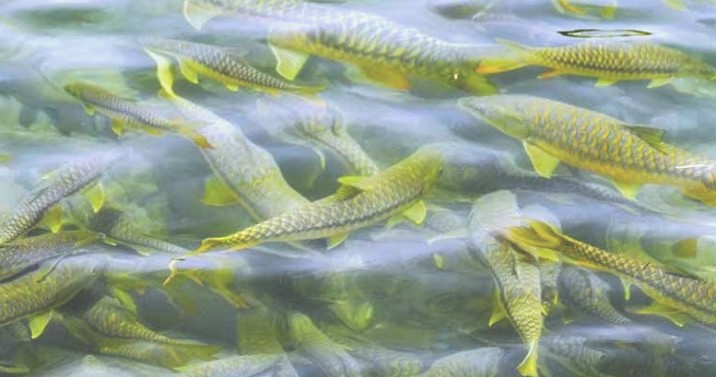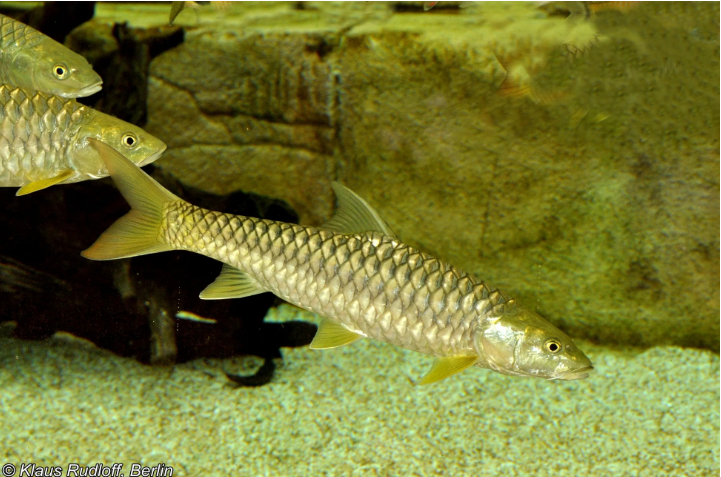Conserving Golden Mahseer through captive breeding. – Department of Fisheries, Himachal Pradesh

Conserving Golden Mahseer through Captive Breeding
Problem
- Drastic population decline of Golden Mahseer due to habitat degradation and overfishing.
- Pollution and loss of breeding grounds threatened natural regeneration.
- Absence of effective conservation protocols or adequate captive breeding infrastructure.
- Inadequate technical capacity and poor survival of juveniles in early hatchery phases.
- Disruption of migratory routes by hydropower and urbanisation projects.
Solution
- Operationalised a dedicated captive breeding hatchery at Machhiyal, Mandi.
- Trained officers at DCFR Bhimtal and implemented disease control, nutritional protocols, and feed innovations.
- Introduced specialised Mahseer-specific juvenile and broodstock feeds.
- Added four new start-feed ponds and scaled fingerling production infrastructure.
- Adopted an integrated strategy combining ex-situ and in-situ conservation efforts.
Outcomes
- Fingerling production increased from <5,000 to 87,000 in FY 2024–25.
- Mahseer ranching was initiated for the first time in Pong (20,000) and Gobind Sagar (13,500) reservoirs.
- Enhanced biodiversity restoration in Beas, Kol Dam, Pandoh, and other river systems.
- Boosted eco-tourism and angling-based economy in Himachal Pradesh.
- Strengthened technical and institutional capacity for long-term species conservation.
SKOCH Award Nominee
Category: State Government – Fisheries Department, Himachal Pradesh
Sub-Category: secState Government – Fisheries Department, Himachal Pradesh
Project: Conserving Golden Mahseer through captive breeding.
Start Date: 1-01-2024
Organisation: Department of Fisheries, Himachal Pradesh
Respondent: Vivek Chandel
https://himachal.nic.in/fisheries
Level: Club Star
Video
See Presentation
Gallery
Case Study
Conservation of Golden Mahseer in Himachal Pradesh
In 2024, the Department of Fisheries in Himachal Pradesh launched a transformative project for conserving the endangered Golden Mahseer (Tor putitora), the State Fish of Himachal Pradesh. Once abundant, the species faced steep population decline due to overfishing, habitat degradation, pollution, and blocked migratory routes.
The National Mahseer Fish Farm at Machhiyal, Mandi—operational since 2016—had long struggled, producing fewer than 5,000 fingerlings annually. To reverse this, the department initiated a comprehensive intervention under the leadership of Director-cum-Warden of Fisheries, Mr. Vivek Chandel, with implementation led by Dr. Som Nath Patiyal and Mr. Mukesh Kumar. Officers underwent specialized training at the Directorate of Coldwater Fisheries Research, Bhimtal, enabling the adoption of global aquaculture best practices.
Key reforms included the introduction of Mahseer-specific feed to improve nutrition and survival rates, expansion of hatchery infrastructure with additional start-feed ponds, and the creation of a robust disease surveillance system. These measures drastically reduced mortality and enhanced breeding efficiency. As a result, fingerling production surged to 87,000 in 2024–25. For the first time, advanced fingerlings were released in large reservoirs such as Pong (20,000) and Gobind Sagar (13,500), along with other riverine systems including the Beas.
The initiative delivered ecological and socio-economic gains. By restoring Mahseer populations, it revitalized angling tourism and created rural employment opportunities in conservation-linked activities. Despite challenges—such as monsoon-induced water fluctuations, feed availability, and broodstock maturity cycles—course corrections through training, resource allocation, and adaptive protocols ensured success.
For more information, please contact:
Vivek Chandel at fisheries-hp@nic.in
(The content on the page is provided by the Exhibitor)


